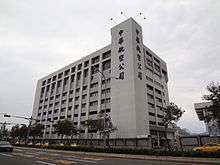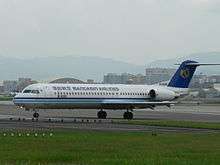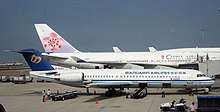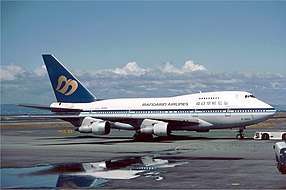Mandarin Airlines
Mandarin Airlines (traditional Chinese: 華信航空; simplified Chinese: 华信航空; pinyin: Huáxìn Hángkōng) is a Taiwanese regional airline based in Taipei, Taiwan, whose parent company is China Airlines. The airline operates domestic and regional international flights, while its parent company focuses on international operations. Some charter services are also operated by the company. Its main hub is Taipei Songshan Airport with others at Taichung International Airport and Kaohsiung International Airport.
 | |||||||
| |||||||
| Founded | 1 June 1991 | ||||||
|---|---|---|---|---|---|---|---|
| Hubs | |||||||
| Focus cities |
| ||||||
| Frequent-flyer program | Dynasty Flyer | ||||||
| Alliance | SkyTeam (Affiliate) | ||||||
| Fleet size | 13 | ||||||
| Destinations | 34 (including charter flights) | ||||||
| Parent company | China Airlines | ||||||
| Headquarters | Songshan District, Taipei, Taiwan | ||||||
| Key people | Samuel P. Lin (Chairman) | ||||||
| Website | |||||||

History

Mandarin Airlines was established on 1 June 1991, and was initially a joint venture by China Airlines (67%) and Koos Group (33%); the Chinese name of the company is formed by the combination of the two.[1] The establishment of Mandarin Airlines is closely related to the political status of Taiwan. At the time, Mandarin Airlines' parent company, China Airlines, still served as the flag carrier of the Republic of China, with the flag of the Republic of China a part of its livery. Denying the existence of the Taipei government, the People's Republic of China hence attempted to boycott the international presence of China Airlines, using trade barriers to achieve its political goal. However, PRC's objection did not extend to other Taiwanese carriers not carrying the ROC flag. As a way to work around these limits, Mandarin Airlines was founded while China Airlines maintained its role as the flag carrier.
On 16 October 1991, Mandarin Airlines started operations with direct flights from Taipei to Sydney in Australia. The next step was the opening of a direct air route to Vancouver in Canada on 7 December 1991. Thus, Mandarin Airlines became Taiwan's first airline to fly direct to Australia and Canada. The China Trust Group pulled its investment in Mandarin Airlines on 31 October 1992, turning the airline into a company virtually wholly owned by China Airlines (90.05%) by December 1992. Also, Mandarin Airlines' role was changed to that of a primary domestic and short-range intra-regional airline,[1] after parent China Airlines was able to re-establish its emphasis on international routes, due to a new livery that did not include the national flag, and thus faced less objection from the PRC.
On 8 August 1999, China Airlines formally merged its subsidiary, Mandarin Airlines, with Formosa Airlines under the Mandarin name. Mandarin took over Formosa's domestic operations and aircraft while Mandarin's fleet and most of its international flights were transferred to China Airlines.[1] In early 2000, the airline bought 5 Dornier 228 from Uni Air to fly outlying routes. These planes were sold to Daily Air in 2005, a helicopter carrier in Taiwan which had won the bid to fly these money-losing routes.
Mandarin Airlines is owned by China Airlines (93.99%) and has 630 employees (as of March 2007).[2]
Corporate affairs
The headquarters is currently in Songshan District, Taipei.[3]
Previously the headquarters was in a different building in Taipei.[4]
Logo
The airline uses Hai Tung Ching (海東青; 海东青; Hǎidōngqīng), a gyrfalcon from a Chinese legend, as its logo.[5]
Destinations
Mandarin Airlines operates the following services as of November 2012 [6] Destinations in China may include scheduled charter service or indirect routing which transit through other countries.
Codeshare agreements
As of November 2012, Mandarin Airlines has codeshare agreements with the following airlines:
Fleet
_taxiing_at_Taipei_Songshan_Airport.jpg)


The Mandarin Airlines fleet comprises the following aircraft (as of September 2019):[7]
Current Fleet
| Aircraft | In fleet | Orders | Passengers | Notes | ||
|---|---|---|---|---|---|---|
| C | Y | Total | ||||
| ATR 72-600 | 7 | 2 | — | 70 | 70 | Delivery starts from 2017[8] |
| Embraer 190 | 6 | — | — | 104 | 104 | |
| Total | 13 | 2 | ||||
Mandarin Airlines announced the lease of eight Embraer 190 aircraft from GE Commercial Aviation Services in December 2005 to replace the aging Fokker 50 and Fokker 100s in its fleet.[9] Mandarin Airlines' E-190's featured a refreshed livery, with the first aircraft delivered in May 2007, becoming the first, and to date the only, Taiwanese airline to use this type of aircraft.[10] On 27 October 2009, Mandarin Airlines retired its last Fokker 100 aircraft, ending this type's 14-year service with the airline.[11] On 19 July 2017 Mandarin Airlines placed orders for six ATR 72-600 aircraft to be delivered in 2018.[12]
Retired Fleet

| Aircraft | Introduced | Retired | Notes |
|---|---|---|---|
| Airbus A340-300 | 2006 | 2007 | |
| Boeing 737-800 | 2000 | 2019 | Returned to China Airlines. |
| Boeing 747-400 | 1995 | 2000 | |
| Boeing 747SP | 1991 | 2004 | |
| Dornier Do 228 | Unknown | Unknown | |
| Fokker 50 | 1999 | 2008 | |
| Fokker 100 | 1999 | 2009 | |
| McDonnell Douglas MD-11 | 1993 | 2004 | B-150 written off as China Airlines Flight 642 |
Accidents and incidents

- China Airlines Flight 642 crashed while landing at Hong Kong International Airport in 1999, resulting in three passenger deaths. The flight was operated by a Mandarin Airlines McDonnell Douglas MD-11.
- On 17 August 2012, Mandarin Airlines Flight 369 experienced a runway excursion during heavy rain due to improper landing and deceleration technique on runway 20 at Magong airport. The E-190 aircraft was intentionally steered off the side of the runway and struck the base of four concrete runway lights causing the nose gear to collapse. No injuries were reported for the accident.[13]
See also
References
- "About Us." Mandarin Airlines. Retrieved on 7 March 2010.
- "Directory: World Airlines". Flight International. 2007-04-10. p. 47.
- "Home." Mandarin Airlines. Retrieved on 8 August 2014. "台北總公司: 10548台北市敦化北路405巷123弄3號 Head Office: No.3, Alley 123, Lane 405 Tunhwa N. Rd., Taipei, 10548 Taiwan"
- "Contact Us." Mandarin Airlines. Retrieved on 15 March 2010. "台北總公司: 105台北市民生東路三段134號13樓."
- "Our business mark and concept of operations." Mandarin Airlines.
- "Our Flight Destinations." Mandarin Airlines.
- "Mandarin Airlines fleet" (December 2017). Retrieved 6 December 2017. Cite journal requires
|journal=(help) - "Taiwan's Mandarin Airlines buys six ATR 72-600s". ATR Aircraft. 18 July 2017.
- "Archived copy". Archived from the original on 3 January 2007. Retrieved 2007-01-17.CS1 maint: archived copy as title (link) CS1 maint: BOT: original-url status unknown (link)
- Air Transport World Archived 2007-09-29 at the Wayback Machine 15 May 2007
- 華信FK-100機隊 光榮除役. Liberty Times (in Chinese). 2009-10-28. Retrieved 18 November 2018.
- Dron, Alan (19 July 2017). "Taiwan's Mandarin Airlines opts for ATR 72-600s". atwonline.com. Retrieved 20 July 2017.
- "Report: Long touchdown of ERJ-190 on wet runway causes runway excursion and nosegear collapse - ASN News". 14 September 2013. Retrieved 18 November 2018.
External links
| Wikimedia Commons has media related to Mandarin Airlines. |
- Mandarin Airlines
- Mandarin Airlines (in Chinese)
- Mandarin Airlines Fleet